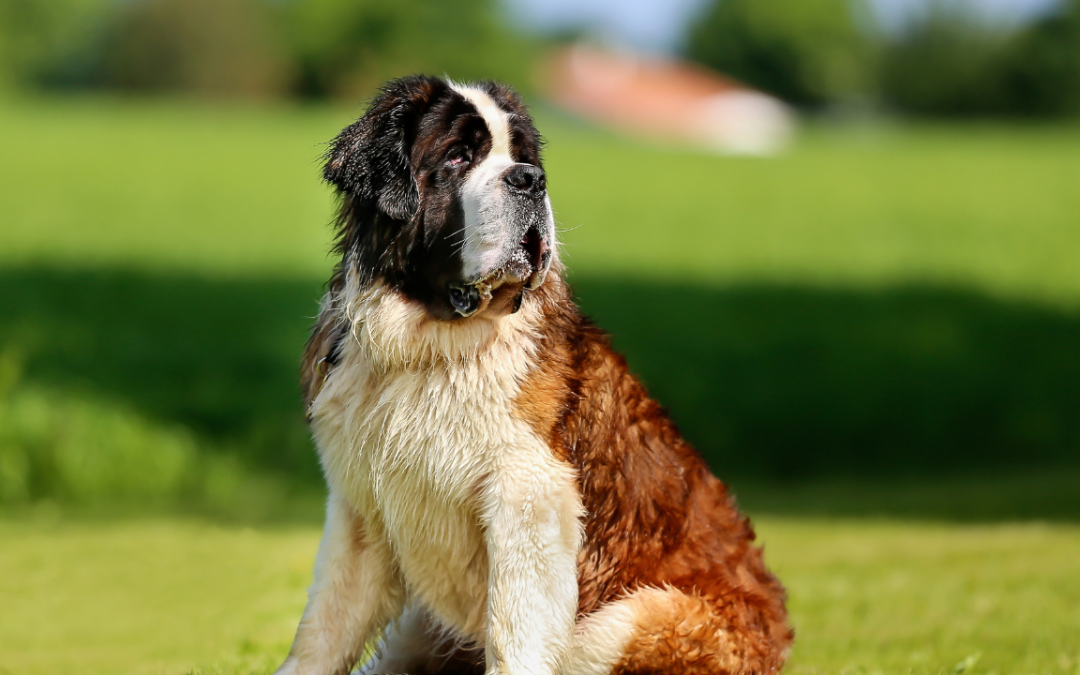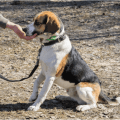Table of Contents
Obedience training can be an undertaking when you decide to do it yourself. However, it can be just as easy. Obedience training is all about teaching your dog to obey certain commands from you – the alpha in the pack.
The foundation of any training should be premised on positive reinforcement – the act of giving your dog rewards to encourage desirable behaviors. The key is to train your puppy using something he values very much; such as his treats and his favorite toys.
You can begin obedience training with your Saint Bernard puppy as soon as you bring him home; usually when he is eight weeks old. Make sure the training sessions are no more than 5 to 10 minutes every day – and they should always end on a good note for both of you. If your dog is having difficulty with learning a new command or behavior; complete the training session with something he has already learned so that you can praise and reward him for it.
Obedience training, or any type of training, should never involve punishing or harming your animal. Positive reinforcement is the only training method that should be mixed up with the reward technique. For instance, if you are teaching your dog a command like “come,” and he actually comes; you should reward him with a treat and also praise him. As soon as he realizes that performing your command will win him goodies; then he would be more than willing to execute any desired command.
The basic obedience commands are:
- Sit
- Stay
- Come
- Lay down
- Heel
Command 1: Training your Dog to “Sit”
“Sit” is one of the basic and most important commands to teach a dog. I also believe it is the first command to introduce to your Saint Bernard dog; because of how easy it is compared to other obedience commands.
Puppies generally find the “sit” command easier to learn, and it also proves effective when you need to stop your doggy from jumping on your guests. An expert dog trainer knows that once you teach a dog to sit on command; learning other commands will no longer be a problem.
Before you start training your Saint Bernard dog to “sit,” ensure you put him in an at-ease state of mind. It also helps to let him go outside before you start each lesson. Always have your training sessions a few hours after your friend has fed. This will ensure that he is neither too full nor too heavy or tired for the training. If you provide him once in the morning and once again in the evening; then he should be more than willing to gain treats in return for learning during the afternoon. “Sit” can be taught using two different methods: capturing and luring.
To train your Saint Bernard dog using the luring method:
- Kneel or sit in front of your pup with a treat in your hand as a lure.
- With the treat in hand, put your hand directly in front of his nose so he can smell it.
- Then, slowly raise your hand (with the treat) above his head and say the “sit” command in a firm but gentle tone.
- The dog will likely sit as he tries to lift his head to sniff, nibble, and possibly snatch the treat from your hand.
- He may attempt to move backward or jump to snatch the treat. If he does this, gently place your palm on his rear end and push him into a sitting position as you repeat the “sit” command.
- Once he achieves the sitting position, give him the treat. It shouldn’t matter whether you guide him through it or not.
- Repeat these steps with treats as a lure.
- Next, use your empty palm and only reward him when he sits again.
- Continue to repeat the steps without using a lure until he learns to sit without assistance once you say the command.
The capturing method, on the other hand, can be employed with these steps:
- Stand in front of your dog with his treats in your hand.
- Naturally, he will sit so that you can feed him the treat. Wait till he sits – say “yes” and then feed him the treat.
- Step backward to push him to stand and wait till he sits again. As soon as his bottom touches the ground, give him another treat.
- Repeat these steps a few times before you start using the “sit” command immediately he begins to sit.
Apart from the luring and capturing method that is suggested; and approved by the American Kennel Club, there is another method you can use if those two do not work for your pup.
- Gently sit or kneel next to your dog.
- Place a palm on his chest, with the side of the palm against his fur.
- Place the other palm on his rear end, with the side of the palm against his fur.
- Softly press the palm into his chest in an upward motion; while you press the one on his rear end in a downward motion. At the same time, instruct him to sit with the command, “sit.”
- Once he reaches a sitting position, offer him a treat as a reward and praise/pet him.
- Repeat these instructions for a couple of minutes during your training sessions until he learns to sit on hearing the command.
Once you have successfully trained your pup to “sit,” and he has mastered it, then you can move to the next command, which is “stay.”
Command 2: Training your Dog to “Stay”
Many trainers regard this as the toughest command to teach and for good reasons. As the social animals that Saint Bernard dogs are, they always want to stay wherever their owners; or familiar human companions are.
It is born out of the instinct to follow the pack. “Stay” is hard to teach because of this, and also because puppies are full of energy and willing to be on the move at all times. Yet, this command is one of the most useful commands you can teach your pet. It comes in handy when you need your pet to stay in one place while you quickly enter the mall or wherever you want to.
A puppy that has learned the “stay” command will know to remain sitting until you tell him otherwise. Staying can be considered a duration behavior. The goal of teaching your pet this command is to get him to stay seated in one spot until you utter a release word or give a clue. To teach your dog to “stay,” you can usually begin by training him with the release word first. Choose the word or phrase you want to adopt as your release clue, something like, “OK” or “Free.”
To teach the release word:
- Get your puppy to sit while you remain in a standing position.
- Throw him a treat on the floor, and say the release word as he moves to get the treat.
- Do this again for a couple of minutes until you can give the release world first and then throw the treat after he takes his steps.
When you train him like this, he comes to associate the word with moving his feet away from the spot he is standing or seated. When your dog has mastered the release cue, you can start teaching him to stay. To do that, follow the tips below:
- Use the “sit” command to instruct him to sit down.
- Once he sits, offer him a treat and praise him – this is for remembering the command.
- Next, tell him to “stay” in a firm but gentle voice and stretch your hand out in front of him to demonstrate that.
- If he remains seated, offer him another treat. If he doesn’t, try the first three steps again.
- Repeat the steps until he learns to stay. But remember not to persist for more than ten minutes at a time.
- If he masters the sit and stay without a problem, proceed to increase the distance between him and you.
- Tell him to “stay” and the move one steps back at a time. Make it slow. When you take like two backward steps successfully without him changing his position, toss him a treat.
- With every distance, he “stays,” make sure you praise and reward him with a treat. You can also slowly approach him and repeat the “stay” command until you can feed him the treat. If he passes at that moment, you can take it up a notch by petting him and letting him know he has done something good.
- If he stands from his sitting position as you approach with the treat, start the steps over again.
- Repeat the method until he masters “sit” and “stay” to the point where he can remain seated while you live the room.
The more your Saint Bernard dog learns, the longer he can learn to sit and stay. Training goals are achieved in measures and increments; hence, you mustn’t expect too much of your pup while he is still undergoing training. Slow down and take the steps one at a time. To ensure he does not forget his training, make sure your sessions are short, simple, and successful. Never make the mistake of telling him to “sit” or “stay” before you leave the house for anywhere though, as this may make him remain in that exact spot until you come back home. That would make for a very terrible experience; so, don’t let it happen.
Command 3: Training your Dog to “Come”
“Come” is a very instrumental command in keeping a Saint Bernard dog safe. If your dog were to break off after seeing another dog on the streets, the command would be very effective for calling him back; so he doesn’t get hit by a car. If you don’t teach him to “come,” incidents like this could result in an accident. This particular command is best taught in a quiet space where there is nothing to distract your pet.
To train him to come:
- Command him to sit and stay in one spot.
- Then, attach his leash to his collar. Make sure you keep his collar on at all times for his safety.
- Grab the leash and command him to “come.”
- As you call out the command, move some steps back each time.
- Pat your leg to show him you want him to move towards you as you say “come.”
- If your pup comes towards you, reward him with a treat, and praise him. If he doesn’t comply, repeat each step above until he does.
- Widen the distance between you both the more he comes closer after the command.
- Every time he reaches you, praise him, and offer him a treat as positive reinforcement.
If that method doesn’t work, try the second method below:
- Sit somewhere near your puppy in a quiet area inside the house.
- Call out his name or the command “word.”
- Every time you call his name or “come,” give him a treat. You don’t have to wait till he responds to the command as you want. Just call out his name or the world repeatedly and give him a treat each time.
- Next, toss a treat on the floor near him. As soon as he eats the treat on the ground, call out his name or the command word again. If he looks up at you, give him another treat.
- Do this again and again for a couple of times until you can toss the treat a little farther away from the pup, and he can turn to look at you when you say his name or the command.
- Be careful not to repeat his name too often, especially if he doesn’t respond. It will make your order easier to ignore. Instead, move towards him and take a step back to the spot where he can successfully react to his name or the command at the first time.
Once your Saint Bernard puppy starts turning around to look at you, start adding movement to make the training more fun for you and him. Throw a treat to the floor and move a few steps away immediately while calling out the command or his name. He should instinctively run after you because dogs find chasing fun. When he catches up to you, reward him with lots of treats and praises. Continue playing games like this while gradually increasing the distance. Take the game outside your house to some other locations, such as the dog park. Remember to use a long leash on your dog while training outside.
Note: Do not reach out or grab your Saint Bernard puppy when he comes to meet you. This might confuse or frighten him. If he is a shy, little furry guy, kneel in front of him and gently grab his collar as you offer him treats. Also, do not at any time use the “come” command to punish your dog. It might make him see you as unpredictable and possibly someone to avoid. Always give him lots of rewards and positive reinforcement any time he responds to his name or the command.
Command 4: Training your dog to “Lay down.”
“Down” usually is easy to learn if you have already taught your Saint Bernard dog to respond to the “sit” command. This is because both commands are trained in similar ways. So, for your dog to grasp the idea of laying down much faster, make sure you teach him to “sit” and “stay” first. If he has mastered both commands, then he is ready to learn “down” much quicker than you realize. You can start teaching your dog to lay down in an empty, small room such as your bathroom and capture the response with positive reinforcement until he masters the command.
- Get a treat or good and have it ready in your hand when you need to give your dog.
- Tell him to sit, and when he does, offer him a treat and praise as his reward for obedience.
- Next, tell him to “stay” with the command word. When he complies, offer him more treats and praise as his reward for compliance.
- Then, hold out a treat in your hand slightly above his head, but close enough for him to sniff with his nose if he were to raise his head towards the treat.
- Once he raises his head at the treat, give him more treats and praises as rewards.
- Now, place your hand with another treat slightly above his head so he can touch it with his nose. Only, don’t give him the treat this time around. Instead, move your hand away and towards the ground slowly. If he follows your movement to the ground with his nose, give him the treat and praise him some more. If he doesn’t, tell him “no” in a firm voice and repeat the steps all over.
- Once he voluntarily starts to follow your hand and the treat to the floor, move on to the next step of the training.
- This time, as soon as the treat touches the ground, move it around and gesture to him to lie down as you do. If he lies down, reward him as usual.
- Eventually, introduce the command “down” or “lay down” so that he can associate it with following the treat to the floor. Once he starts responding to the command and following the movement, shower him with lots of treats and praises.
- If he has learned to associate the hand movement towards the floor with his action, you can start practicing the movement with just your empty hand. Then, give him his treat after he successfully lies down.
Just as it is with teaching the “sit” command, never use force to put your pup in the position you want. And as usual, make training fun so he can learn faster. End every training session on a light and positive note. If you observe that your doggie is having a hard time getting the command or simply being stubborn, reevaluate the value of your reinforcement and rewards. More importantly, review the speed of training. See if there is a need to slow down with the lessons to make them easier, or if your pooch simply wants a bigger reward for labor.
Command 5: Training your Dog the “Heel” Command
The heel command is used in obedience training to teach a Saint Bernard dog to walk on the side of its human while the leash is loose. Advanced puppy training is even easier when your puppy is relaxed and can work on a loose leash politely, without pulling, tugging, or trying to get away. If “heel” sounds a little dated or obsolete for you, then you can use other commands such as “let’s go” or “forward.” Anything that spells “walk beside me gently even though I have your leash on loose.” Teaching yourself the “heel” makes walking to the park or anywhere else much easier for both of you. Once your pup has mastered this command, you can worry less about him pulling ahead of you or lagging way behind; you will be on an even walking speed.
- Wear your dog’s leash on him and hold the leash away from your dog.
- Hold your dog’s favorite treat in the hand near your dog; hold it between the thumb and your index finger. Make sure your dog can see the treat in your hand.
- As you start walking, give the “heel” command. S
- Try to keep the leash loose without pulling at it repeatedly. If you don’t, your dog will create a negative association with the leash.
- Walk some distance from your home and give your dog the treat you are holding if he successfully remains close to you while you are both walking.
- Make the distance longer when he masters staying by your side for shorter distances.
- If he tries to lag or pull away during the training, encourage him to stay by your side using his favorite treats.
Before you start training, you should ensure that your Saint Bernard dog is comfortable putting on a leash. Wearing a leash might feel strange at first, and he might even bite the leash. Give him some treats whenever you have to put the leash on.
It helps to note that your dog might have some difficulty learning the “heel” command if he is a hunting dog or breed. Usually, hunting dogs find it hard to resist following scent or sight. If your Saint Bernard dog is finding it hard to learn the command, try using another tool such as a harness with a front lead to training him. Train him to “heel” with the harness and then repeat the lessons over and over with a leash once he has learned the command in the harness. Do not use prong collars or choke chains for training while teaching your pooch this command.
These five commands are a usual beginner training for Saint Bernard little pups. They serve as the foundation for the puppies’ everyday lives. As your pup masters each command, he becomes more loyal and more accommodating towards its humans, but mainly you, the trainer. Respect and bond are formed during the essential training carry on when you want to begin advanced training sessions with your puppy. Advanced training should start when you are confident your dog has mastered the basic commands. This should be around when he is a year old and no longer a puppy. Advanced commands include “quiet,” “leave it,” “speak,” and many others.






 Author and long-time animal lover. Sharing knowledge on pet care through experience and the written word.
Author and long-time animal lover. Sharing knowledge on pet care through experience and the written word.